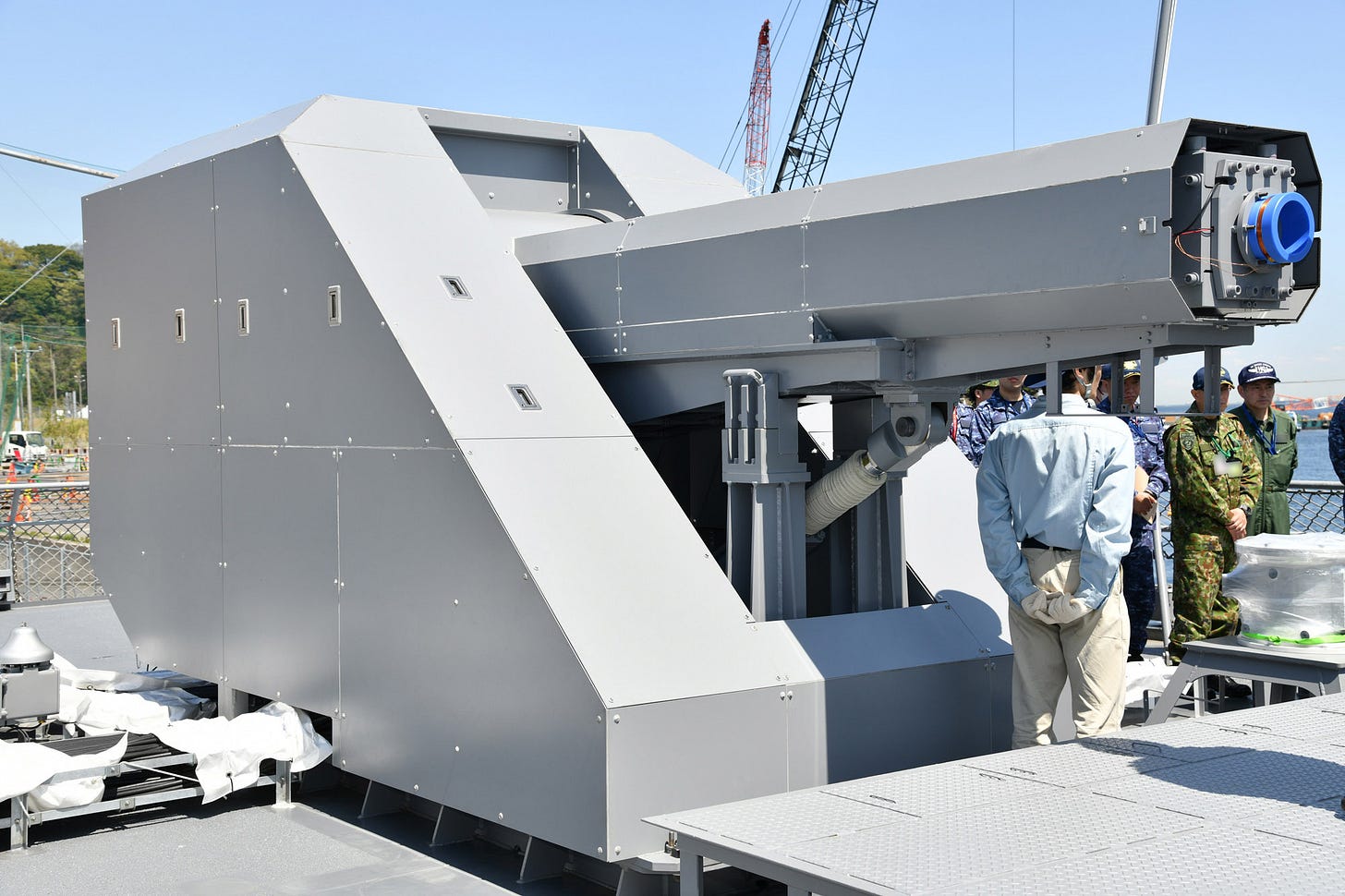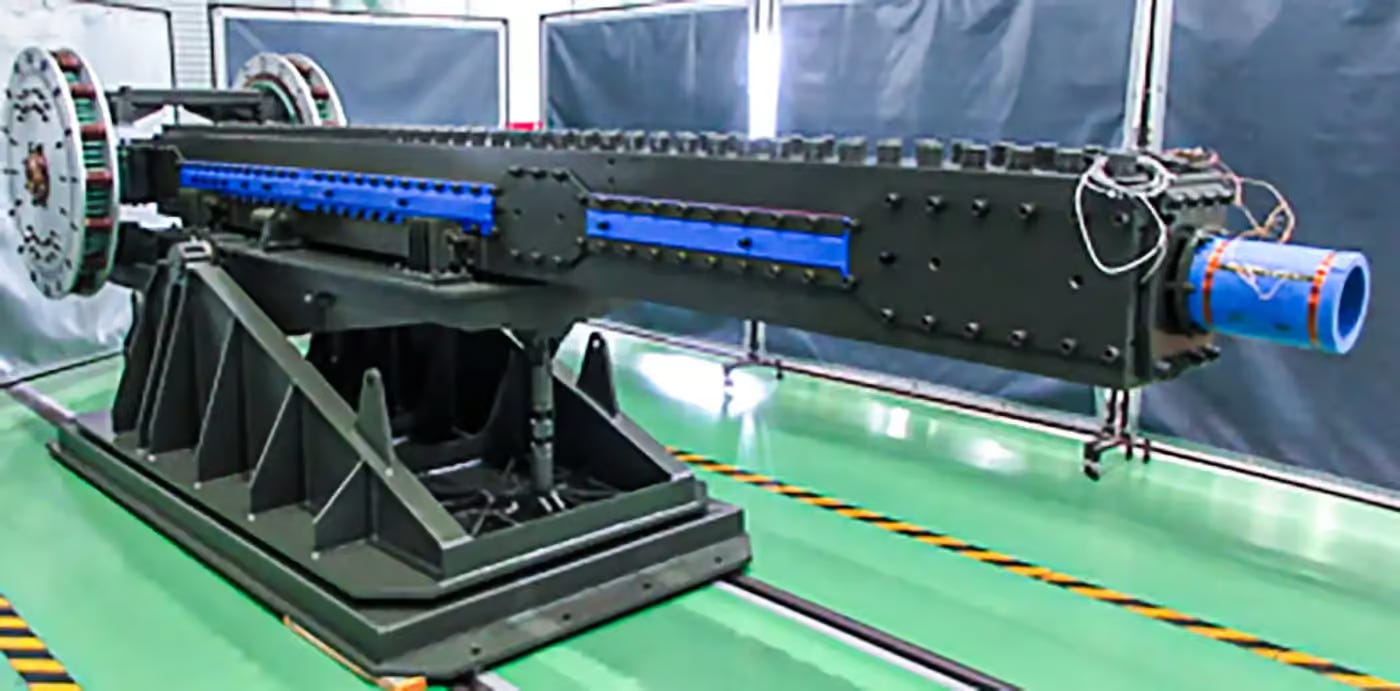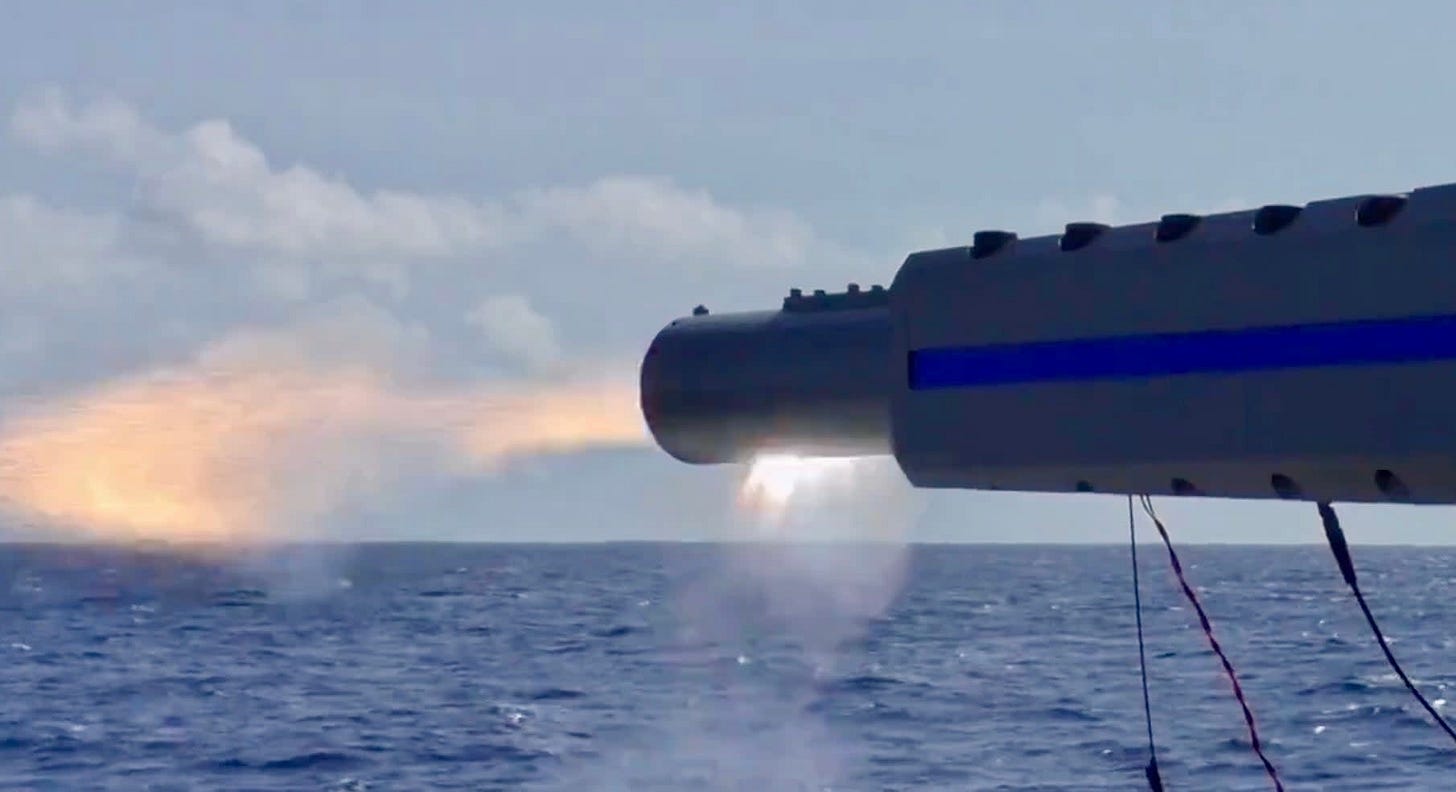Japan has mounted a railgun onto a ship for testing.
The advanced railgun uses electromagnetic energy to launch projectiles at hypersonic speeds of over 5000 miles an hour.
The Engineer's Perspective is a reader-supported publication. Sign and up and subscribe to see more in-depth Aerospace/Aeronautical Analysis!
Introduction and Overview
The Japan Maritime Self-Defense Force (JMSDF) has taken a technological lead over the United States with the installation of an electromagnetic railgun on a test ship. The railgun program has seen significant progress with initial installation and testing on the JS Asuka. A dedicated testbed with a warship-like design, the 6,200-ton-displacement vessel has been used to support the development of weapons and other naval systems since it was first commissioned into Japanese service in 1995.
Aimed at developing enhanced capabilities to address modern naval warfare challenges, the railgun system utilizes electromagnetic forces to accelerate and launch projectiles at hypersonic (Mach 5+) velocities.
The Japanese railgun system holds promise for enhancing naval defense by providing a rapid-fire, high-velocity projectile delivery method. It may offer potential benefits in intercepting advanced threats and reducing some of the costs associated with traditional missile-based defense systems, The goal is to develop a practical weapon system that can effectively counter emerging threats while offering advantages in cost and operational flexibility.
This approach to munitions offers a potential alternative to traditional gunnery and missile systems, particularly in scenarios requiring rapid response and sustained engagement. The program has been motivated by evolving regional security dynamics, such as the increasing prevalence of sophisticated missile technologies and a desire to maintain a technological edge in maritime defense.
Historical Development
Japan’s railgun research formally began in the mid-2010s under the direction of the Ministry of Defense’s Acquisition, Technology & Logistics Agency (ATLA). This initiative was part of a broader effort to explore advanced weapon systems to counter emerging threats. Key milestones in the program's development include:
Early Research and Development: Initial efforts focused on fundamental research into electromagnetic launch technology. This involved developing laboratory-scale prototypes to explore the basic physics and engineering challenges of railgun operation. These early prototypes achieved muzzle velocities exceeding Mach 6, demonstrating the potential of the technology to deliver projectiles at hypersonic speeds.
Prototype Development: Building on the initial research, ATLA progressed to the development of a 40mm-caliber railgun prototype featuring a 6-meter barrel. This prototype was designed to test the practical aspects of railgun construction, power delivery, and projectile design.
Shipboard Testing: A significant milestone was achieved with the first shipboard installation and firing tests conducted on the JS Asuka in 2023. These tests marked a critical step in transitioning the technology from the laboratory to a realistic naval environment. The tests aimed to evaluate the railgun's performance under operational conditions, including its integration with shipboard power systems and fire control systems.
Ongoing Development: Current efforts are concentrated on addressing key challenges, such as reducing the size and weight of the power supply system. Miniaturization is crucial for integrating the railgun onto operational warships, which have limited space and power resources. Additionally, research is ongoing to integrate the railgun system with land-based platforms for coastal defense roles.
Implications
The deployment of railgun technology carries several significant implications for Japan's defense strategy, technological development, and regional security:
Defense Enhancement: Railguns offer a potentially transformative means to intercept and neutralize high-speed threats, particularly hypersonic missiles and advanced cruise missiles. Unlike traditional interceptor missiles, railguns can launch projectiles at extremely high velocities, potentially extending the engagement range and reducing the time to intercept. Moreover, the cost per shot for a railgun is projected to be significantly lower compared to deploying interceptor missiles, making it a more sustainable solution for sustained defense operations. This enhancement would improve Japan's layered defense capabilities, providing an additional layer of protection against advanced aerial threats.
Strategic Deterrence: The development and deployment of railgun technology sends a clear signal of Japan's commitment to investing in advanced defense capabilities. This can serve as a deterrent to potential adversaries by demonstrating Japan's resolve to defend its interests and its capacity to respond to emerging threats. By fielding cutting-edge technology, Japan aims to complicate the calculations of potential aggressors and discourage hostile actions.
Technological Leadership: Japan's investment in railgun technology positions it at the forefront of electromagnetic weapon development globally. This leadership can lead to potential spin-off benefits for civilian and industrial applications, such as advanced materials, power generation, and transportation systems. Furthermore, the development of railgun technology can stimulate innovation in related fields, contributing to Japan's overall technological competitiveness.
Operational Flexibility: Railguns can be adapted for both shipborne and land-based deployment, offering enhanced flexibility in defense planning. Shipborne railguns can augment naval defense capabilities by providing a rapid-response intercept capability against anti-ship missiles and aircraft. Land-based railguns can be strategically deployed to protect key infrastructure, coastal areas, and military installations. This versatility allows Japan to tailor its defense posture to address a wide range of threats across different operational environments.
Specifications
The Japanese electromagnetic railgun prototype showcases a range of advanced technical specifications designed for high-performance projectile launch. Key details include:
Caliber: The prototype features a 40mm caliber, which defines the diameter of the projectile it launches. While 40mm is the current size, future iterations may explore different calibers based on operational requirements.
Barrel Length: The railgun utilizes a 6-meter barrel. Barrel length is a crucial factor in determining the projectile's acceleration and final velocity. Longer barrels generally allow for greater acceleration and higher muzzle velocities.
Weight: The current prototype weighs approximately 8 tons. The weight is a significant consideration for shipboard deployment, as it impacts the stability and maneuverability of the vessel. Ongoing research focuses on reducing the system's weight to facilitate integration on a wider range of naval platforms.
Muzzle Velocity: The railgun has demonstrated muzzle velocities of up to 2,297 meters per second, which is approximately Mach 6.5. This extremely high velocity enables the projectile to reach distant targets rapidly, increasing the probability of a successful intercept.
Power Source: The railgun is powered by a large pulse power supply system. This system is essential for generating the intense electromagnetic field required to accelerate the projectile. Miniaturization of the power supply is a primary focus of current development efforts to enable practical deployment on naval vessels.
Platform: The current testing platform is the JS Asuka, an experimental ship designed to evaluate new weapon systems for the JMSDF. The JS Asuka provides a realistic maritime environment for testing the railgun's performance and integration with shipboard systems.
Intended Roles: The railgun is intended for a variety of roles, including anti-missile defense, anti-ship engagements, and coastal defense. Its high velocity and long range make it well-suited for intercepting incoming missiles and engaging surface targets at a distance.
Special Weapons: The railgun does not use explosive propellants, which is a key distinction from traditional artillery systems. Instead, it relies on electromagnetic force to accelerate the projectile. This results in several advantages, including higher muzzle velocities, potentially greater range and accuracy, and reduced risk of on-board explosions.
The railgun system does not utilize explosive propellants; instead, it launches projectiles using electromagnetic force, resulting in higher velocities and potentially greater range and accuracy.
Concept of Operations
The electromagnetic railgun system represents a next-generation weapon technology designed to enhance the defense capabilities of the Japan Maritime Self-Defense Force (JMSDF) by providing rapid-response, long-range, and high-velocity firepower. This derived CONOPS outlines the operational framework, objectives, and procedures for utilizing the railgun system to achieve optimal performance during naval and coastal defense operations.
Stakeholders
JMSDF: Primary operator and end-user of the railgun system.
ATLA: Oversees research, development, and procurement of the technology.
Defense Planners: Integrate the railgun into overall defense strategies and force structures.
Naval Engineers: Responsible for the integration, maintenance, and support of the system on naval vessels.
Purpose
The primary purpose of the railgun system is to provide a rapid, long-range, high-velocity means of defense for naval vessels and coastal areas, enabling the interception of advanced threats, such as hypersonic missiles, and engagement of surface targets.
Operational Overview
Pre-Deployment Operations:
System Integration: The railgun system is integrated with the ship's power grid, fire control system, and sensor arrays to ensure seamless operation.
Crew Training: Naval personnel undergo specialized training to operate and maintain the railgun system effectively.
System Checks: Comprehensive system checks are performed to verify the readiness of the railgun before deployment.
Engagement Operations:
Target Detection: The ship's sensors detect incoming threats or designated targets.
Target Acquisition: The fire control system acquires and tracks the target.
Engagement: The railgun launches projectiles at extremely high velocities to intercept or engage the target.
Post-Engagement Operations:
System Evaluation: The performance of the railgun system is assessed after each engagement to identify areas for improvement.
Maintenance: Routine maintenance is performed to ensure the railgun system remains in optimal operating condition.
Potential for land-based deployment:
Strategic Placement: Railguns may be situated at key locations such as around naval ports, or in defense of critical infrastructure.
Integration with Surveillance: Land based railguns will be integrated with surveillance and radar systems for optimal protection of assets.
Key Capabilities
High rate of fire, allowing for rapid engagement of multiple targets.
Extended range, providing a greater standoff distance for defense.
Reduced cost per shot compared to missile-based interceptors.
Non-explosive ammunition, reducing the risk of on-board explosions.
Summary
The railgun system is designed for use in both naval and coastal defense scenarios. On naval vessels, the system will be integrated into the ship's layered defense architecture, providing a rapid-response intercept capability against incoming missiles and aircraft. Land-based railguns will be strategically deployed to protect key infrastructure and coastal areas. The railgun will offer high speed and high precision strikes against targets. The system will provide both naval ships and land-based defense with the latest technology and maximum protection.
6. Systems Engineering
This systems engineering overview is for the Japanese electromagnetic railgun system. It addresses basic Systems Engineering considerations for the development and deployment of the railgun, such as its objectives, how it meets these objectives, and potential challenges it may encounter. It is only high level and not comprehensive, but provides a fair idea of what Systems Engineering practices may generate for the system, and takes into account assumptions that may not have been applied to the actual system.
System Objectives
Primary Functions: The primary functions of the railgun system are to provide a rapid, long-range, high-velocity means of defense for naval vessels and coastal areas, enabling the interception of advanced threats, such as hypersonic missiles, and engagement of surface targets.
Key Operational Capabilities: Key operational capabilities include a high rate of fire, extended range, reduced cost per shot compared to missiles, and minimal explosive risk due to the use of non-explosive ammunition.
Mission Requirements: The system must be capable of engaging and neutralizing incoming missiles, aircraft, and surface threats. It must also be adaptable for both shipborne and land-based deployment scenarios.
Performance Goals: Specific performance goals include achieving muzzle velocities exceeding Mach 6, maintaining a high degree of accuracy, and demonstrating a high rate of fire during engagement scenarios.
Operating Conditions
Environmental Parameters: The system must be designed to operate in a range of environmental conditions, including exposure to saltwater, humidity, vibration, and temperature variations typical of maritime environments.
Operational Constraints: Operational constraints include limitations on the size and weight of the system for shipboard integration and power limitations imposed by the available infrastructure.
Infrastructure Requirements: The system requires a high-capacity power supply capable of delivering the necessary electrical energy for each shot. It also requires integration with shipboard fire control and sensor systems.
Maintenance Conditions: Maintenance procedures must be designed to be performed within reasonable timeframes using standard naval tools and equipment.
Expected Opposition/Challenges
Potential Threats/Competitors: Potential threats include advanced missile systems and competing railgun technologies developed by other nations.
Countermeasures/Advantages: The railgun's high velocity, long range, and reduced cost per shot provide key advantages over traditional missile-based defense systems. The system's non-explosive ammunition also reduces the risk of on-board explosions.
Design Considerations
Modularity for upgrades
Scalability for future growth
Interoperability with existing systems
Cost-effectiveness in production and operation
Verification and Validation
Define testing procedures
Outline simulation requirements
Specify acceptance criteria
Determine certification needs
Systems Engineering Requirements
Based on the Concept of Operations and available data, the following Systems Engineering Requirements are derived for Japan’s electromagnetic railgun system:
Functional Requirements
The system shall launch projectiles using electromagnetic force to achieve hypersonic velocities.
The system shall operate in multiple modes, including anti-missile defense, anti-ship engagement, and coastal defense.
The system shall maintain a high rate of fire to engage multiple threats sequentially.
The system shall integrate with shipboard sensors, fire control systems, and power grids.
The system shall achieve projectile velocities exceeding Mach X (Threshold) and aim for Mach Y (Objective).
Physical Requirements
The system shall adhere to size and weight constraints compatible with naval vessel integration (e.g., prototype weight: ~8 tons).
The system shall utilize conductive, high-strength materials to withstand electromagnetic forces, thermal stress, and barrel wear.
The system shall incorporate a pulse power supply capable of delivering X energy per shot, with provisions for miniaturization.
The system shall maintain structural integrity under repetitive high-stress firing conditions.
Environmental Requirements
The system shall operate within a temperature range of X°C to Y°C, accounting for maritime and land-based environments.
The system shall withstand humidity levels up to X% and saltwater exposure without degradation.
The system shall maintain electromagnetic compatibility with onboard ship systems to avoid interference.
The system shall function at altitudes up to X meters above sea level for coastal deployment.
Maintenance Requirements
The system shall support maintenance intervals not exceeding X hours of operation.
The system shall require standardized naval tools and diagnostic equipment for routine servicing.
Maintenance personnel shall possess specialized training in high-energy electromagnetic systems.
The system shall include modular components to streamline spare parts replacement.
Interface Requirements
The system shall provide a human-machine interface compliant with JMSDF operational standards.
The system shall exchange data with shipboard combat management systems via standardized protocols.
The system shall interface with external power grids and surveillance networks for land-based deployment.
Safety and Reliability Requirements
The system shall meet JMSDF safety standards for high-energy electromagnetic systems, including arc flash and thermal hazard mitigation.
The system shall achieve a mean time between failures (MTBF) of X hours under operational conditions.
Critical subsystems (e.g., power supply, cooling) shall incorporate redundancy to ensure continuous operation.
The system shall include fail-safes to prevent unintended discharges or component damage.
Design Considerations
Modularity: The system shall allow for incremental upgrades to energy storage, rail materials, and cooling systems.
Scalability: The design shall support future integration on larger naval platforms and adaptation to increased caliber requirements.
Interoperability: The system shall align with existing JMSDF shipboard architectures and land-based defense networks.
Cost-effectiveness: Production and operation shall prioritize affordability while maintaining performance thresholds.
Verification and Validation
Testing Procedures: Live-fire trials shall validate muzzle velocity, accuracy, and rate of fire against representative targets.
Simulation Requirements: Computational models shall simulate thermal management, electromagnetic interference, and barrel wear.
Acceptance Criteria: The system shall demonstrate compliance with velocity, range, and reliability metrics during sea trials.
Certification Needs: The system shall obtain JMSDF certification for operational deployment after successful testing.
Note: “X” and “Y” denote threshold and objective values to be determined during detailed design phases, informed by ongoing prototyping and testing.
Calculations:
Two calculations we can generalize are the Mach speed of the gun, and the approximate range of the round.
The formula for the range R is:
Where:
Vo^2 is the initial velocity,
θ is the launch angle,
g is the acceleration due to gravity (approximately 9.81 m/s2).
We can calculat
Assumptions: Initial velocity is the fastest, at 2,297 meters per second:
Converted, 2,297 meters a second is 5,184 miles an hour:
Conversion calculations leave 5,184 miles an hour being approximately Mach 6.5 at sea level:
The result is the railgun is firing at approximately Mach 6.75
This equation assumes there is no air resistance and the projectile lands at the same height from which it was launched. So Mach 6.5 may account for air resistance.
With the assumption that θ is the launch angle of 45 degrees, putting the values into the range equation, we get:
Not taking into account wind resistance or wind diverting the round, a the rail gun firing at 45 degrees would reach somewhere in the realm of 537km or 333 miles.
Conclusion
Japan’s railgun program, exemplified by the prototype installed aboard the experimental vessel JS Asuka, represents a pivotal step in the nation’s response to a changing threat landscape—particularly the proliferation of hypersonic missiles, ballistic projectiles, and swarm drone tactics. As traditional interception systems face increasing saturation risks and rising operational costs, electromagnetic railguns offer a compelling alternative with their ability to launch projectiles at hypersonic velocities using pure electrical energy. This translates to a nearly instantaneous time-to-target and drastically reduced cost-per-shot—two critical factors in sustaining future high-tempo, multi-domain engagements.
Despite technical hurdles—chiefly in power storage and conditioning, barrel wear, and heat dissipation—the decision to integrate and test this system at sea signals Japan’s intent to operationalize directed-energy technologies in the near future. Efforts are already underway to miniaturize onboard power systems and adapt the railgun for compatibility with modular naval platforms, such as the upcoming 13DDX destroyers, and potentially land-based installations for island defense roles.
Strategically, the railgun aligns with Japan’s broader push toward self-reliant defense technologies amid regional tensions and evolving alliance dynamics. Collaborations with U.S. and European defense research institutions further reinforce Japan’s commitment to interoperability while accelerating shared innovation cycles. The railgun, therefore, is not merely a technological experiment—it is a strategic investment in deterrence credibility, layered defense architecture, and future-proofing against emerging threats.
As development matures, Japan’s railgun could potentially become a cornerstone in both naval and homeland defense, marking a paradigm shift in how kinetic threats are countered across the Indo-Pacific region.
References
🔗 Key References on Japan’s Railgun Program
📄 “Electromagnetic Railgun: A Near Term Weapon Technology” (DTIC PDF)
📄 “Technology Focus: Electromagnetic Railguns” (DRDO PDF, Oct 2022)
📰 News Articles
🛡️ Japan Releases Image of Railgun Installed on Naval Vessel – Naval News
⚓ Railgun Installed On Japanese Warship Testbed – Yahoo News
🌐 Railgun Installed On Japanese Warship Testbed – The War Zone
🔭 Japan Sends Defense Official to U.S. Navy for Railgun Development – The Japan Times
🛰️ Japanese Weapons Agency Sends Official to U.S. – Defense Mirror
📸 Photos Capture US Ally's Futuristic Railgun on Navy Ship – Newsweek
🛠️ Japan to Test New Variant of Electromagnetic Railgun on JS Asuka – Army Recognition
🤝 Video: Japan Joins European Efforts for Railgun Research – Naval News
🎥 Video Coverage
The Engineer's Perspective is a reader-supported publication. To receive new posts and support my work, consider becoming a free or paid subscriber.








